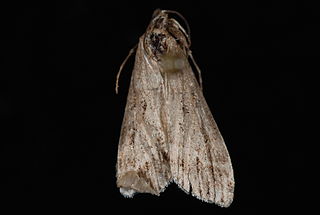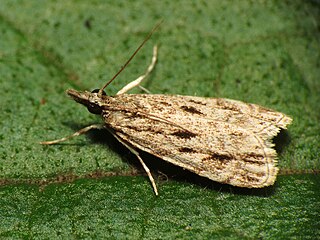
Eudonia is a large and widespread genus in the grass moth family (Crambidae), subfamily Scopariinae. There is no common name for the roughly 250 species placed here; new species are still being described regularly. Although the genus was proposed early in the 19th century, many of these moths were for a long time retained in Scoparia, the type genus of the subfamily and a close relative of Eudonia. A few small genera have been proposed for separation from Eudonia, but given the size of this group this is not particularly convincing; thus, all are retained here pending a comprehensive phylogenetic review.

Eudonia echo is a moth of the family Crambidae described by Harrison Gray Dyar Jr. in 1929. It is found in western North America from British Columbia to California.

Harrison Gray Dyar Jr. was an American entomologist. Dyar's Law, a pattern of geometric progression in the growth of insect parts, is named after him. He was also noted for eccentric pursuits which included digging tunnels under his home. He had a complicated personal life and along with his second wife he adopted the Baháʼí Faith.
Eudonia extincta is a moth in the family Crambidae. It was described by Harrison Gray Dyar Jr. in 1921. It is found in the Distrito Federal of Mexico.

Eudonia commortalis is a moth in the family Crambidae. It was described by Harrison Gray Dyar Jr. in 1921. It is found in North America, where it has been recorded from Alaska to British Columbia, Washington and California.

Eudonia albertalis is a moth in the family Crambidae. It was described by Harrison Gray Dyar Jr. in 1929. It is found in North America, where it has been recorded from Alberta to British Columbia, Washington, Idaho and Wyoming.
Eudonia crassiuscula is a moth in the family Crambidae. It was described by Harrison Gray Dyar Jr. in 1929. It is found in Brazil (Paraná) and French Guiana.
Eudonia excursalis is a moth in the family Crambidae. It was described by Harrison Gray Dyar Jr. in 1929. It is found in Costa Rica.
Eudonia inexoptata is a moth in the family Crambidae. It was described by Harrison Gray Dyar Jr. in 1929. It is found in Mexico.

Eudonia leucophthalma is a moth in the family Crambidae. It was described by Harrison Gray Dyar Jr. in 1929. It is found in North America, where it has been recorded from British Columbia and Alberta to Washington and California.
Eudonia ycarda is a moth in the family Crambidae. It was described by Harrison Gray Dyar Jr. in 1929. It is found in Guatemala and Orizaba, Mexico.
Eudonia expallidalis is a moth in the family Crambidae. It was described by Harrison Gray Dyar Jr. in 1906. It is found in North America, where it has been recorded from Washington to Nevada and California.
Eudonia schwarzalis is a moth in the family Crambidae. It was described by Harrison Gray Dyar Jr. in 1906. It is found in North America, where it has been recorded from Arizona.

Eudonia strigalis, the striped eudonia moth, is a moth in the family Crambidae. It was described by Harrison Gray Dyar Jr. in 1906. It is found in North America, where it has been recorded from Nova Scotia to southern Ontario and south to Florida.
Eudonia torniplagalis is a moth in the family Crambidae. It was described by Harrison Gray Dyar Jr. in 1904. It is found in North America, where it has been recorded from South Dakota, the Rocky Mountains, the mountains of the south-western United States and from British Columbia to southern California.
Scoparia albipunctata is a moth in the family Crambidae. It was described by Herbert Druce in 1899. It is found in Costa Rica and Guatemala.
Scoparia denigata is a moth in the family Crambidae. It was described by Harrison Gray Dyar Jr. in 1929. It has been recorded from the US state of Arizona.
Scoparia ulmaya is a moth in the family Crambidae. It was described by Harrison Gray Dyar Jr. in 1929. It is found on the West Indies, where it has been recorded from Guadeloupe.
Wellesca Pollock Allen Dyar was an American educator and an early adherent to Baháʼí Faith in the United States. She was at the center of a Washington, D. C. society scandal in 1916.

John Bernhardt Smith was an American professor of entomology who specialized in systematics and economic entomology while also serving as the State Entomologist of New Jersey. Smith is remembered in insect taxonomy for the conflict that he had with Harrison Dyar.







